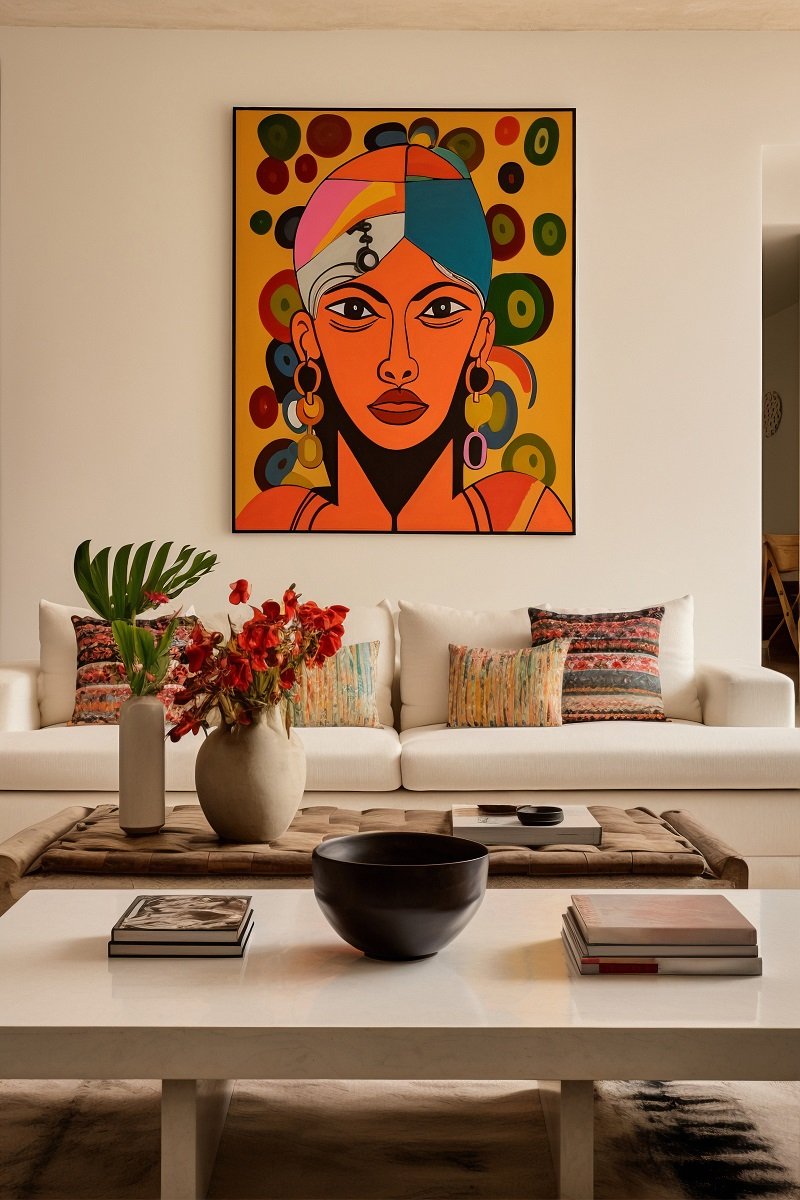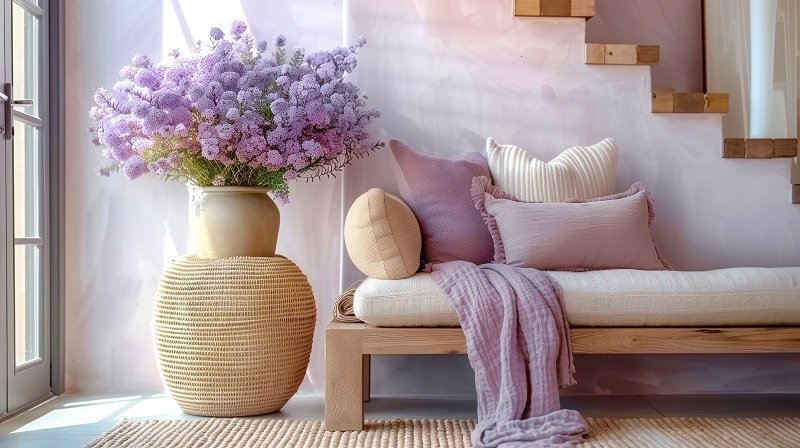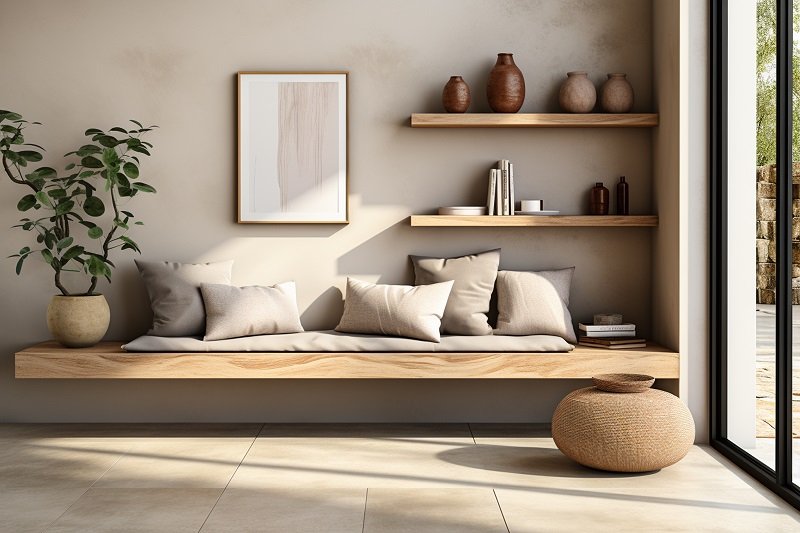Blog
How to Arrange a Sofa in the Living Room?
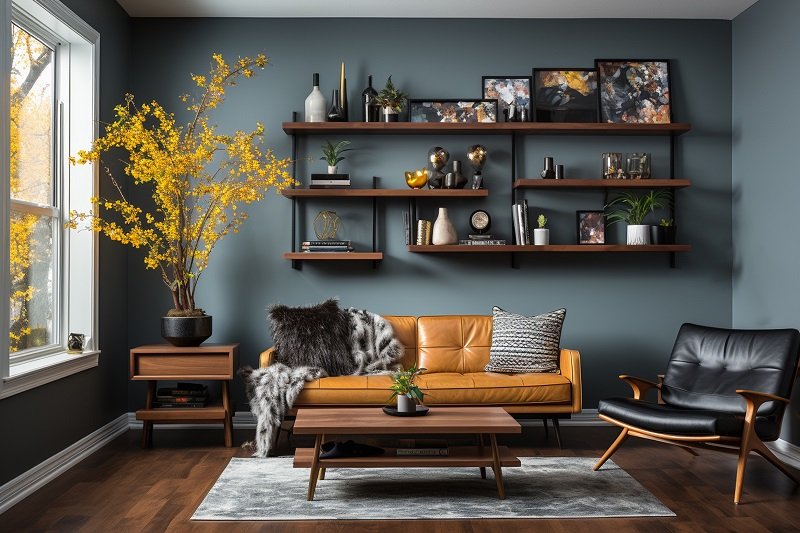
Introduction
A lot of people confront a common problem when looking to buy a sofa set online or at a furniture store: the arrangement of their living room. Others have a similar difficulty, but they have already purchased their sofa set without considering how they would arrange it in the living room, and when they enter the living room, a chaotic arrangement of furniture interrupts the sense of peace they want. The room is messy, and the location that should be your sanctuary is everything but.
A well-organized living room is more than just arranging furniture against the walls; it is about creating a place that is harmonious, useful, and welcoming. Whether you’re moving into your first apartment or looking to improve your house, how you arrange your sofa may have a big influence on the entire atmosphere of your living room.
Begin with a Plan
Every successful project requires a strategy and a plan, and arranging your living room sofa is no exception. Consider these items while making the plan; What are the main activities that will take place in this room? (e.g., watching TV, entertaining guests, reading), Do you have any specific requirements, like a need for extra seating or space for a coffee table?
Sketching Out Ideas:
- To generate ideas, start by drawing your living room on paper or using a computer tool.
- Mark the location of doors, windows, and other architectural features that may influence your furniture placement.
Visualizing Various Arrangements:
- Consider the flow of movement across the room. Make sure there is a clear path for walking and that the design does not block natural light or airflow.
- Experiment with various setups. For example, place the sofa in the middle of the room or near a wall and observe which feels more welcoming.
Probable Plans
- Open-Plan Living Rooms: In open-plan spaces, consider using your sofa to create distinct zones. For example, place the sofa with its back to the dining area to visually separate the two spaces while maintaining an open feel.
- Small Living Rooms: In smaller rooms, a loveseat or compact sectional might be the best fit. Floating the sofa slightly away from the wall can create an illusion of more space and provide room for accent tables or floor lamps.
Take Measurements
Understanding your space’s measurements before buying a sofa set online or from a store is the first step in creating a well-organized living room. Measurements serve as the blueprint for your arrangement, ensuring that each piece of furniture fits exactly without dominating the space or appearing out of place. Accurate measurements are essential for a harmonious design.
1- Measure Your Living Room:
- Begin by measuring the length and width of your living room.
- Take note of the height of your ceilings, since this might influence the size of the furniture you purchase.
2- Measure Existing Furniture:
- When adding new pieces to existing furniture, it’s important to measure their proportions.
- Allow plenty of room for paths and ensure that doors and windows can completely open.
3- Consider the Scale and Proportion:
- Choose furniture that is appropriate for the size of your space. A huge sofa may dominate a small space, whereas a little loveseat may appear lost in a vast living room.
- To achieve a unified effect, balance bigger and smaller elements.
Floor Plan Softwares
In the age of technology, we have a variety of tools at our disposal to help us design and arrange our living environments. Floor plan software may be a game changer especially for those who want to buy sofa sets online, to allow you to experiment with alternative layouts without moving a single item of furniture. Use floor plan software to visualize and test out alternative layouts.
- Room Styler 3D is a user-friendly application for creating comprehensive 3D models of your living room. You may drag and drop furniture items into your model, changing the colors and finishes to meet your preferences.
- Planner 5D provides 2D and 3D views to explore your room from various viewpoints. Includes a large library of furniture and décor pieces, allowing you to design your living space with realistic aspects.
- Armstrong Flooring offers a tool for seeing the impact of different flooring selections on furniture arrangements. It helps you to coordinate your sofa arrangement with the overall style of your living space.
Find Your Focal Point
Every well-designed living room has a focal point—a visual anchor that pulls the attention and establishes the tone of the area. Identifying and arranging furniture around this focal point may improve both the room’s appearance and functioning.
1- Identify Your Focal Point: Identify your main point, which might be a fireplace, huge windows, art items, or television. In other circumstances, an architectural element such as a built-in bookcase or accent wall might act as a focal point.
2- Arrange Furniture to Highlight the Focal Point: Arrange your sofa and other seats to face or compliment the main point. Maintain the focal point’s visibility and accessibility, which will improve the general balance and flow of the room.
Optimize Small Spaces (Small Living Room Layouts)
Arranging furniture in a small living room can be challenging, but with thoughtful planning, even the tiniest spaces can feel open and inviting. Maximize small spaces with strategic furniture placement and multi-functional pieces.
1- Choose Multi-Functional Furniture:
- Opt for pieces that serve more than one purpose, like a sofa bed or an ottoman with storage.
- Consider furniture that can be easily moved or reconfigured as needed.
2- Use Light Colors and Reflective Surfaces:
- Light-colored furniture and decor can make a small room feel larger and more open.
- Mirrors and glass surfaces reflect light and give the illusion of more space.
3- Create Vertical Storage:
- Use shelves and tall furniture to take advantage of vertical space.
- Wall-mounted units free up floor space and keep the room uncluttered.
Examples:
- Small Apartment Living Room: A sofa with built-in storage and a fold-out bed may give seating, storage, and sleeping space while taking up minimal space.
- Tiny House: Floating bookcases and wall-mounted TV stands save crucial floor space, making the room feel less crowded.
Consider Left or Right Seating
Understanding the flow of movement in your living room, as well as natural seating choices, may considerably improve the space’s comfort and utility. Set up seats to suit the natural flow and user preferences.
1- Observe Natural Movement Patterns:
- Pay attention to how people move through your living room.
- Arrange seating to facilitate easy movement and accessibility.
2- Position Seating for Comfort and Accessibility:
- Ensure that key seating areas are easily accessible from the main entry points.
- Consider the natural light sources and position seating to take advantage of them.
How to Choose the Right Sofa for Your Living Room?
Selecting the perfect sofa is crucial as it often becomes the centerpiece of your living room, influencing both the style and comfort of the space.
1- Consider the Size and Scale:
- Measure your living room to ensure the sofa fits comfortably without overwhelming the space.
- Think about how the size of the sofa relates to other pieces of furniture and the room’s overall scale.
2- Think About Style and Comfort:
- Choose a sofa style that matches your home’s decor, whether it’s modern, traditional, or eclectic.
- Comfort is key—consider the sofa’s cushioning, seat depth, and fabric.
3- Evaluate Functionality:
- Consider how the sofa will be used: for lounging, entertaining, or as a sleeper.
- Look for features like reclining seats, storage, or modular sections that can be rearranged.
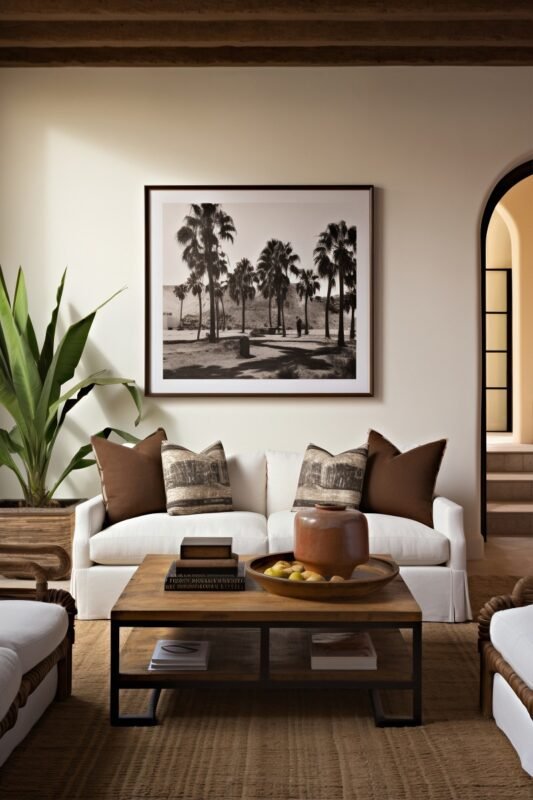
Consider the Scale and Proportion
Proper scale and proportion guarantee that all of the pieces in your living room work together to create a well-balanced and visually appealing area.
- Match Furniture to the Room Size. huge furniture can overpower a tiny area, while little items might appear lost in a huge space. Make sure there’s enough room to move around comfortably without being crowded.
- To balance your furniture, consider its height in relation to the ceiling and other items. Use a variety of widths and heights to provide visual interest without confusion.
Furniture Functionality
The functionality of your furniture plays a significant role in how your living room is used and enjoyed. Choose functional furniture that meets your practical needs and enhances your lifestyle.
Multi-Functional Pieces:
Look for furniture that serves more than one purpose, like a sofa bed or a coffee table with storage. Consider pieces that can be easily moved or adjusted to suit different activities.
Durability and Maintenance:
Choose materials that are durable and easy to clean, especially if you have kids or pets. Consider the long-term maintenance of the furniture to ensure it stays functional and looks good over time.
Living Room Style
Your living room’s style shows your taste and sets the tone for the entire home. Define your style to create a cohesive and inviting living space. Determine whether your style is modern, traditional, bohemian, industrial, or a mix. Use online resources, and magazines, before buying a sofa set online. Don’t be afraid to blend different styles to create a space that’s uniquely yours. Balance is key—mixing too many styles can make a room feel chaotic.
Examples:
- Modern Bohemian: Combine sleek, modern furniture with boho accents like textured pillows, rugs, and plants for a relaxed yet stylish look.
- Industrial Chic: Use metal and wood furniture with exposed brick and vintage accessories to create an industrial feel with a touch of warmth.
Create Zones
Creating different zones in your living room may assist in maximizing space while also making it more practical and organized. Divide your living space into several zones to suit diverse activities.
- Identify key activities for your living room, including sitting, reading, entertaining, and working. To establish a sense of organization, provide a separate location for each task.
- Arrange furniture to organically divide the room. For example, use a sofa to separate the lounging area from the eating or working area. Rugs, bookshelves, and room dividers can also serve to define various zones.
- To create a coherent design, use the same color palette and style throughout the zones. To avoid a chaotic or scattered effect, ensure that the different regions flow naturally.
Experiment with Layouts
Trying out different furniture layouts can help you discover the most effective and aesthetically pleasing arrangement for your living room.
Begin with the main pieces of furniture, such as the sofa and TV stand, and then place smaller items around them. Consider the room’s focal point and make sure the primary furniture pieces are facing it. Do not be scared to rearrange furniture to explore what works best. Sometimes a simple modification may have a large impact. Before making any physical alterations, use floor plan tools such as Room Styler 3D, Planner 5D, or Armstrong Flooring to view numerous layout options. Aim for a balanced appearance by properly dispersing furniture across the space. Make sure there is adequate room for mobility, and that the arrangement encourages conversation and engagement.
Tips for Arranging Furniture
How to Arrange Furniture Around a TV: Position the television at eye level for optimal viewing. Arrange seats to face the television, so that everyone has a clear view.
How to Arrange Furniture Around a Fireplace: Arrange chairs around the fireplace to create a focal point. To balance the room, position furniture on either side of the fireplace.
How to Use the Television and Fireplace as Focal Points: Arrange seats to create a dual focus point, with the TV and fireplace visible. To incorporate the TV into the fireplace area, use built-in bookshelves or a media cabinet.

Don’t Place Seating Furniture Against the Walls: Move furniture away from the walls to create a more intimate and appealing seating space. Use rugs to separate the seating area and add a sense of comfort.
Allow for Conversation: Arrange seating such that chairs and sofas face one other. Avoid arranging furniture in a straight line, as this might limit interaction.
Consider an additional seating area: If space allows, set up a secondary seating area with a couple of chairs and a small table. This may be used as a reading corner or a space for informal talks.
Place the Non-sitting Furniture: Set up coffee tables, side tables, and consoles to match the sitting arrangement. For convenience, keep tables close to the seating area.
Choose the Right Coffee Table: Select a coffee table that is proportional to the seating area. Ensure there is enough space around the table for easy movement.
Consider a Sofa Table: Place a sofa table behind a floating sofa to provide additional surface space. Use the table for decorative items or as a spot for lighting.
Use a Rug in the Main Seating Area – Select The Right Size Area Rug: Choose a rug that is large enough to anchor the seating area. Ensure all seating pieces have at least the front legs on the rug.
Layer in Accessories – Hanging the Right Size Art: Use accessories like pillows, throws, and art to add personality to your living room. Hang art at eye level and choose pieces that complement your decor.

Consider a Small Dining Area: If space allows, create a small dining area within the living room. Use a round table and chairs to save space and promote a cozy atmosphere.
Choose Multipurpose Furniture: Look for furniture that can serve numerous purposes, such as a storage ottoman or a sleeping sofa. This is particularly beneficial in tiny rooms.
Use Walls More Efficiently: Maximize vertical space by installing shelves or cupboards. To conserve floor space, install wall-mounted lights instead.
Use broad Window Sills: Use broad window sills for additional sitting or display areas. Use cushions or plants to make the most of the sills.
Place Your Plants Based on Their Needs: Place plants in areas where they will receive adequate lighting. To include greenery in your design, use plant stands or hanging planters.
How to Add Proper Lighting to Your Living Room: Layer different types of lighting, including ambient, task, and accent lighting. Use floor lamps, table lamps, and overhead fixtures to create a well-lit space.
Remember the Traffic Flow: Ensure there are clear pathways for movement throughout the living room. Avoid placing furniture in high-traffic areas.
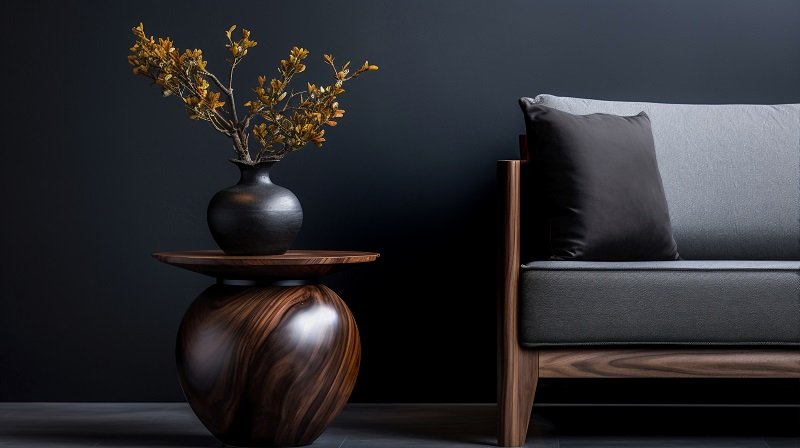
Conclusion
Arranging your sofa and other living room furniture is a combination of art and science. You can create a beautiful, useful, and pleasant living room by carefully planning, taking into account your space and needs, and experimenting with alternative arrangements without any fear of buying your sofa set online.
Venus Home Furniture recognizes the value of a well-organized living room. We hope these suggestions and ideas help you build a home that you and your loved ones will appreciate for many years to come. Remember that balancing design, comfort, and usefulness is essential for creating a harmonious and welcoming workplace.
FAQs
1- What is the best way to start arranging my living room furniture?
Start by creating a plan and taking accurate measurements of your living room. Use floor plan software like Room Styler 3D, Planner 5D, or Armstrong Flooring to visualize different layouts and experiment with various arrangements.
2- How do I choose the right sofa for my living room?
Consider the scale and proportion of the sofa in relation to your living room size. Think about the sofa’s functionality and how it fits into your lifestyle. Ensure it complements your living room style and meets your comfort needs.
3- How can I make the most of a small living room?
Optimize small spaces by choosing multipurpose furniture, creating zones, and using vertical space efficiently. Avoid pushing all furniture against the walls and consider pieces that offer storage solutions.
4- What is a focal point, and why is it important?
A focal point is a dominant feature in a room that draws the eye. It could be a fireplace, a TV, or a large window. Arranging furniture around a focal point helps create a cohesive and visually appealing space.
5- How do I arrange furniture around a TV and a fireplace?
To combine the TV and fireplace as focal points, arrange seating so that both elements are easily viewable. Use built-in shelving or a media console to integrate the TV with the fireplace area, creating a balanced look.
6- What are some tips for creating a cozy conversation area?
Arrange seating furniture to face each other, encouraging interaction. Use a rug to define the space and pull furniture away from the walls to create a more intimate and inviting setting.
7- How can I create different zones in my living room?
Identify the key activities you want your living room to accommodate, such as lounging, reading, and entertaining. Use furniture, rugs, and accessories to define separate areas for each activity, ensuring a cohesive overall look.
8- What should I consider when choosing a coffee table?
Select a coffee table that is proportional to the seating area. Ensure there is enough space around the table for easy movement and that it complements the style of your living room furniture.
9- How can I effectively use rugs in my living room?
Use a rug to anchor the main seating area, ensuring it is large enough to accommodate all seating pieces at least partially. Choose a rug that complements your color scheme and adds texture and warmth to the space.
10- What are some lighting tips for the living room?
Layer different types of lighting, including ambient, task, and accent lighting. Use floor lamps, table lamps, and overhead fixtures to create a well-lit space. Ensure lighting is functional and enhances the room’s atmosphere.



